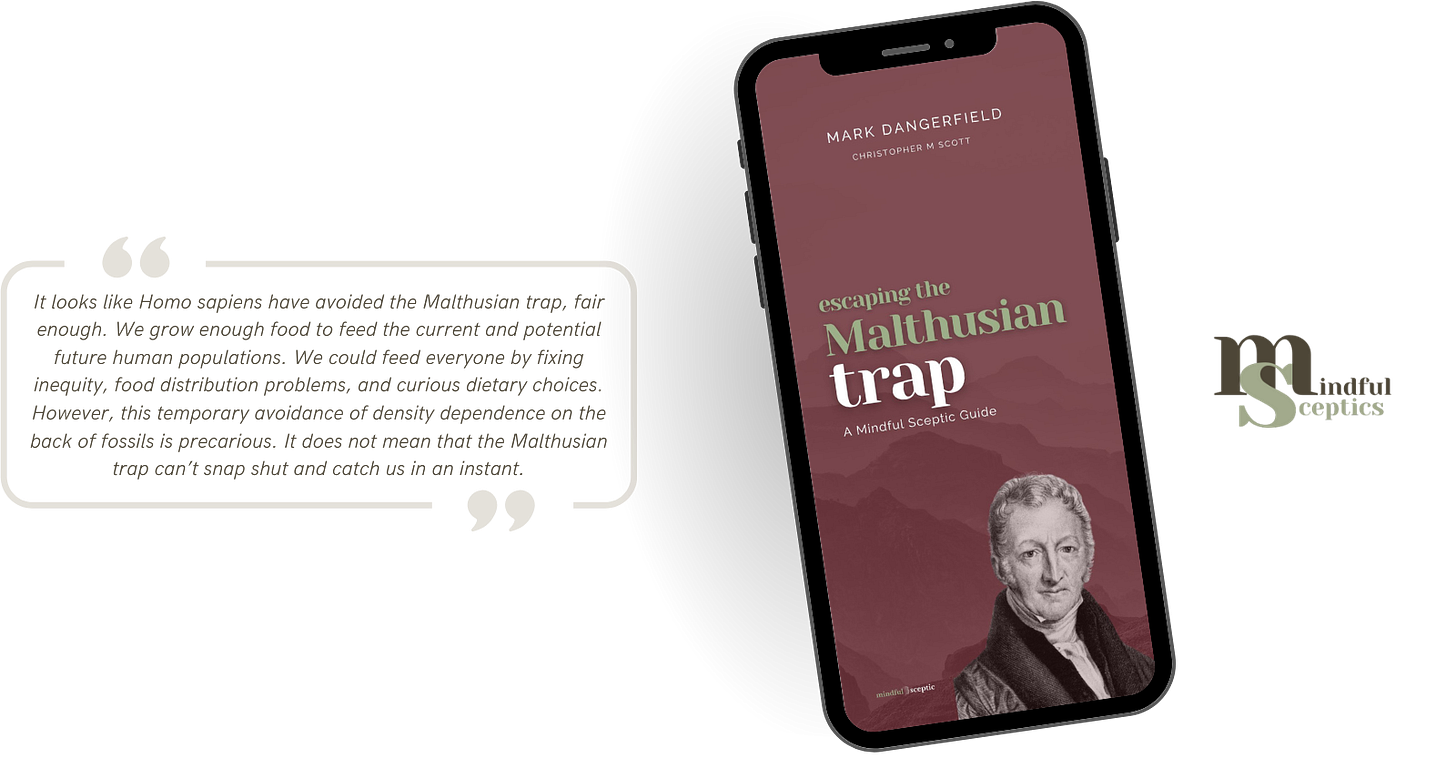Core Idea
Most people believe the extraordinary transformation of human civilisation over the past 200 years represents the natural trajectory of human progress. We call it development, advancement, the march of civilisation, and it’s a reasonable assumption given population exploding from 1 billion to 8 billion, living standards soaring, and technology advancing at a breakneck pace.
The accompanying story goes that humans simply got smarter, worked harder, and unlocked our potential through innovation and industriousness. This narrative assumes what we’ve experienced is normal, sustainable, and destined to continue indefinitely.
This comfortable fiction underpins everything from economic policy to personal life planning. We expect growth, anticipate improvement, and structure entire societies around the assumption that tomorrow will always be bigger and better than today.
The Great Acceleration becomes not just what happened, but what humans do. It is our species finally hitting its stride after millennia of struggling in the wilderness.
Counterpoint
The Great Acceleration is not progress.
It is an anomaly from a one-time fossil fuel pulse that temporarily lifted the carrying capacity of Earth beyond anything experienced in human history.
For 290,000 years, modern humans were just large mammals scattered across landscapes in small groups, constrained by the basic biological reality that energy is finite and populations are regulated by resource availability. We followed the same ecological rules as all animals, competing for limited resources with the outcomes you’d expect from density dependence.
Then we discovered concentrated sunlight buried in the ground, called it coal, oil, natural gas, and everything changed. Not because we evolved or became inherently superior, but because we stumbled upon a massive energy subsidy that allowed us to cheat on our own biology.
The Haber-Bosch process alone, converting atmospheric nitrogen into fertiliser using fossil fuel energy, supports nearly half the current global population. Remove that energy pulse, and we return to being large mammals competing for resources, subject to the same ecological laws we’ve temporarily suspended.
The metrics are stark.
In 1988, global energy use was 29,847 TWh. Today it’s over 170,000 TWh per day, with four out of five units coming from fossil fuels.
We consume 22 trillion calories daily in food and have commandeered 50% of habitable land to achieve this feat.
This isn’t sustainable development; it’s ecological overshoot funded by a finite resource we’re burning through at an extraordinary rate.
What we call civilisation’s triumph is actually humanity living on borrowed time and borrowed energy. The moment that subsidy ends—and it will end—we discover whether 8 billion humans can persist within Earth’s actual carrying capacity.
Early evidence suggests we cannot.
Thought Challenges
Energy Dependency Audit… Calculate your personal energy consumption beyond just electricity and gas bills. Include the fossil fuel energy embedded in your food (fertilisers, processing, transport), manufactured goods, and services. Research how much of your lifestyle would be possible with only renewable energy sources available in your local region. What parts of your daily existence depend entirely on the fossil fuel subsidy?
Historical Perspective Exercise… Study population and resource data from before 1800 and compare it to post-1950 trends. Chart the correlation between energy consumption and population growth. Ask yourself if alien archaeologists found our civilisation in 10,000 years, would they classify the Great Acceleration as normal human development or as an anomalous blip in an otherwise stable pattern?
Closing Reflection
Recognising the Great Acceleration as an anomaly rather than progress forces an uncomfortable reckoning with reality.
It means our entire modern conception of normal is built on exceptional circumstances that won’t last. This doesn’t mean we’re doomed because anomalies can create lasting changes if managed wisely. But it does mean we need to design systems and societies for the actual world we live in, not the temporarily expanded one we’ve grown accustomed to.
The question isn’t whether progress will continue, but whether we can engineer a soft landing from our anomalous height back to the biological realities that govern life on Earth.
Evidence Support
Rockström, J., Steffen, W., Noone, K., Persson, Å., Chapin, F. S., Lambin, E., ... & Foley, J. (2009). “A safe operating space for humanity.” Nature, 461(7263), 472-475.
TL;DR… presents the ‘planetary boundaries’ framework, identifying nine global processes that regulate Earth system stability, several of which have already been exceeded, particularly those related to climate, nitrogen cycling, and biodiversity. The authors argue that transgressing these boundaries threatens global sustainability, demonstrating that humanity’s current resource demand is unsustainable.
Relevance to insight… strong quantitative evidence that humanity relies on ecological subsidies (e.g., fossil fuels and intensification) but that Earth’s systems are being compromised, making technological escapes from resource traps only temporary without systemic change.
Seidl, I., & Tisdell, C. A. (1999). “Carrying capacity reconsidered: from Malthus’ population theory to cultural carrying capacity.” Ecological Economics, 31(3), 395-408.
TL;DR… evolution of the carrying capacity concept from classical Malthusian population theory to its contemporary applications, showing how technological advancement delays but does not eliminate ecological limits. The authors highlight the critical role of cultural, economic, and technological factors in shaping resource constraints and population outcomes.
Relevance to insight… demonstrates that population growth and resource use are fundamentally limited by ecological carrying capacity, even as cultural and technological factors modify—but cannot abolish—these constraints.
Dorling, D. (2021). “World population prospects at the UN: Our numbers are not our problem?” In The Struggle for Social Sustainability (pp. 129-154). Policy Press.
TL;DR… population growth has plateaued in developed regions due to the demographic transition, but continues in countries not yet through this transition. He discusses how population stabilisation is not enough to ensure sustainability, given continued overconsumption and uneven resource use.
Relevance to insight… demographic transition as necessary but insufficient for escaping ecological resource traps, highlighting how population momentum and uneven transition rates leave humanity vulnerable to Malthusian constraints.
Amundson, R., Berhe, A. A., Hopmans, J. W., Olson, C., Sztein, A. E., & Sparks, D. L. (2015). Soil and human security in the 21st century. Science, 348(6235), 1261071.
TL;DR… how agricultural intensification—enabled by the Haber-Bosch process—allowed food production to grow exponentially with population. However, they warn that this success has come at a great cost: large-scale soil degradation and pollution signal future risks to food security and ecological health.
Relevance to insight… biophysical basis for humanity’s apparent escape from the Malthusian trap, showing that reliance on fossil-fuel-dependent soil management is unsustainable as it undermines key ecological foundations of continued population growth.
Kamankutty, U. B., Mehrauli, K., Maha, R., Karvis, J., Freeman, P., Serrero, M., & Xieselberg, Y. (2024). Trends in global agricultural land use: implications for environmental health and food security. Annual Review of Plant Biology, 75, 219-241.
TL;DR… expansion and intensification of agricultural land use since 1700, emphasising that calorie production per capita has never been higher, but at enormous environmental cost. Malnutrition, obesity, and persistent food insecurity coexist due to distribution failures and ecological overshoot, despite technological advances.
Relevance to insight… technology and global agricultural innovation have temporarily enabled population growth and resource escape, yet the resulting environmental harms signal the limits of technological optimism and the need for system-wide sustainability.






